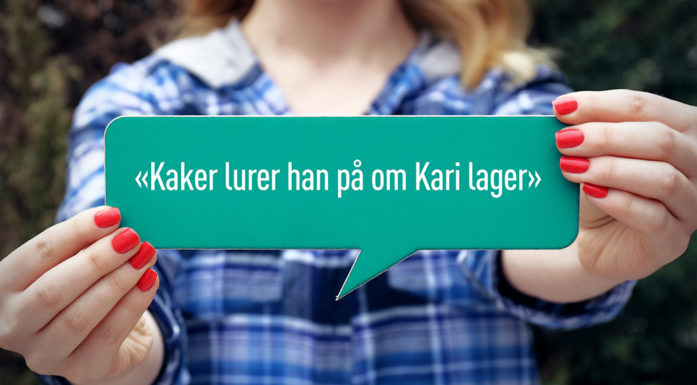Little words are better than their reputation
“Meaningless” little words create nuances and meaning in our language and can make our communication more effective.
A lot of people think “little words” are just fillers and don’t add any meaning to sentences. But language researcher Kaja Borthen believes they are important and enrich the language.
A conversation without these little words – called pragmatic particles by linguists – feels strange. Although we can’t always easily explain what these words add to a sentence, it doesn’t mean that they’re meaningless.
Borthen compares pragmatic particles with other human characteristics, such as the fact that we can walk, but may have difficulty explaining just how we do it.
More than words
Professor Borthen at NTNU’s Department of Language and Literature has led the research project entitled The meaning and function of Norwegian tags, which addresses particles that are hard to define.
“Pragmatic particles give colour to the language, and they influence how the rest of the sentence content comes across.”
Semantics is the branch of linguistics concerned with what words, phrases and sentences mean. Pragmatics is about how the context contributes to the meaning of the content. Norwegian words like da, jo, visst, altså, ass, liksom, vel, nok, and ikke sant are called “pragmatic particles” or “tags” when they don’t specifically refer to another word. Pragmatic particles are more commonly used in conversation than in writing.
But what do these little words do?
“They can signal whether the speaker feels certain or uncertain, positive or negative about what the speaker is saying. Tags indicate what the speaker assumes the audience knows about the sentence content,” says Borthen.
“Tags can dampen or reinforce meaning, bind content and influence whether the utterance should be interpreted as an order, a claim or a question. And they can signal identity. Little words give colour to our language. They influence how we should interpret the content of the rest of the sentence,” she adds.
Don’t particles tend to be used too often?
Borthen says tags usually have a very general meaning, which allows them – in principle – to show up in all kinds of sentences. And using them too often minimizes their impact – like with inflation. Repetition is always annoying, but that doesn’t mean that particles are always superfluous.
Big Brother in the lab’s toolbox
The text laboratory at the University of Oslo has large digital databases for linguists to immerse themselves in. Borthen’s colleague Signe Rix Berthelin searched the text lab’s toolbox of transcribed text from the TV series Big Brother when she was studying the use of the particle jo.
There she found that the participants in the reality series used the word jo almost 700 times per 100 000 words. By comparison, Norwegian newspaper texts revealed nine instances of jo per 100 000 words, while legal texts had zero occurrences of the word.
In addition to analysing speech and text, the researchers have incorporated questionnaires and experiments into the study, including measuring the reaction time of subjects who interpret the statements.
Useful tag, that sjø
Trøndelag county residents love the particle sjø, which is a contraction of “do you see?” Similar terms are found in numerous places. The Østfold county version is se, while other areas use the variant ser du. Sjø is useful because it shows how the content of the sentence relates to something that the speaker has said before.
Example without sjø:
– Vil du være med på tur, Anne? Would you like to go for a walk, Anne?
– Nei, helst ikke. (pause) Æ e så sulten. No, I don’t think so. (pause) I’m so hungry.
Example with sjø:
– Vil du være med på tur, Anne? Would you like to go for a walk, Anne?
– Nei, helst ikke. (pause) Æ e så sulten, sjø. No, I don’t think so. (pause) I’m so hungry, [you see].
In the first sentence, Anne makes it clear that she does not want to walk. The fact that she’s very hungry may be introducing a new topic. The sentence with sjø clearly explains why Anne does not want to walk: she’s very hungry. By using sjø, Anne also suggests that being hungry is probably new information for the person she’s talking to. Sjø also reveals the geographical connection to the Trøndelag dialect. The researchers found the word used in parodies of the Trøndelag residents.
Da binds together
The word da can in many cases seem meaningless, but Borthen doesn’t agree.
“When it comes at the end of a phrase, it can indicate a justification for what was said and suggest that the content of the sentence contrasts with other views. If you ask for permission to take a picture and I say Javel, da! (Well, OK!), it can easily be understood as ‘I’m saying yes only because you’re asking, even though I’d really prefer that you didn’t.’ In other cases, da can make it clear that the topic of the conversation is continuing despite a pause or break. In other words, da creates connection,” she says.
Distinctly Norwegian doubling
One of the strangest constructs in the Norwegian language is the repetition of a pronoun at the end of a sentence – a so-called right dislocated pronoun. Some people simple consider it poor language, and the phenomenon is unusual in other languages. But Borthen thinks it serves a function.
When some person in the middle of a meeting gets up and says: jeg må gå, jeg (I have to go,[I]), it’s not quite the same as just saying: I have to go. Repeating the pronoun at the end makes the statement a little less abrupt and more polite. Borthen believes that the most important thing about the repeating pronoun is to signal a break, a discontinuity or a contrast. In this case, the doubling contrasts the expectation that “everyone should stay at the meeting until it ends” with a person leaving the room anyway.
Manipulative jo
In the sentences Du har da vært der før and Du har jo vært der før (both: You have been there before), the particles da and jo are perceived as reinforcing. Both particles present the content of the sentence as something the listener has reason to believe is true. But they are not exactly the same. Language researcher Berthelin thinks one of the differences between da and jo has to do with when the listener became acquainted with the content of the sentence. Da infers that the listener has access to “proof” that the claim is correct, while jo implies that the listener is already familiar with the content. Da is more open to the audience’s objections. Jo is better suited to manipulating the audience, says Borthen, who thinks it’s a good idea to be attentive to when it is appropriate to use the particle jo.
“If you say: Donald Trump er jo en fantastisk president (Donald Trump is a wonderful president [you know]), you’re suggesting that the person you’re talking with agrees with you. This can make the other person feel like they’re being manipulated.”
Tricky for foreigners
Because Norwegians are not even fully aware of how they use these little words, it goes without saying that they pose a challenge for foreigners who need to learn Norwegian. Borthen believes there are still a lot of unanswered questions, both about the individual words themselves and the universal characteristics of pragmatic particles. To create interest in the topic and educate new researchers, Borthen and two colleagues are writing a textbook on pragmatics.
Now that’s exciting, isn’t it?
Read more:
- The NOT study project: The meaning and function of Norwegian tags
- Popular scientific website on Norwegian particles (in Norwegian)
- Norwegian Linguistic Journal issue on Norwegian particles (in Norwegian)







